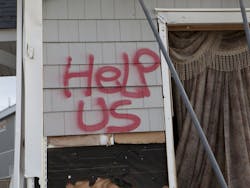Microgrid to Safeguard Emergency Medicine Supply for Disaster Relief Group
Direct Relief, a not-for-profit charitable organization, has installed a microgrid at its 155,000 square foot warehouse in Santa Barbara, Calif., to help ensure it can fulfill its mission to provide medicine and medical supplies for disaster relief.
The idea for the installation was “largely informed by our experience in Puerto Rico” where Direct Relief helped the island recover after it was devastated by Hurricane Maria in September 2017, according to Tony Morain, director of communications for Direct Relief.
Maria caused the longest blackout in U.S. history, and disaster relief and recovery efforts on the island were compounded by the lack of power for health facilities. The Center for Disease Control said that about 80 percent of the island’s supplies of medicine were compromised because of a lack of refrigeration.
According to anecdotal reports, healthcare facilities in Puerto Rico were spending as much as $80,000 per month to pay for backup generation, Morain said.
That experience made Direct Relief realize how vulnerable it was with its single medical warehouse in Santa Barbara. The area is “fairly isolated, with only one freeway in and out” and a single pair of transmission lines connecting it to the Southern California grid, Morain said. “It is not inconceivable that we could be faced with a prolonged power outage.”
Disaster relief warehouse vulnerable
That concern was heightened recently when California utilities said they could shut off the power to transmission lines during high wind events to prevent wildfires.
With the newly installed microgrid, Direct Relief can run its warehouse “as a self-contained power island for months on end,” Morain said.
The warehouse already had a backup diesel generator, but as Direct Relief learned in Puerto Rico, diesel generators are not meant to power a facility for extended periods of time. “They get hot and break down and are expensive,” Morain said.
Direct Relief’s new microgrid includes 320 kW of direct current power from solar panels and a 676 kW battery system from Tesla.
“The novel thing Tesla did was to design a system that can switch between diesel and solar and backup power,” Morain said.
Nominations are now open for the Microgrid Knowledge Greater Good Award. The winner will be announced at Microgrid 2019, which will be held May 14-16 in San Diego.
The existing 600-kW diesel engine has a 4,000 gallon fuel tank that could provide the warehouse with power for a week. Direct Relief estimates adding solar and storage facilities to the mix could stretch that to three months.
The microgrid at its Santa Barbara warehouse is Direct Relief’s first, and the organization is paying for it out of pocket. “It is part of the cost of doing business. It will enable us to respond” even if there are events that would have otherwise “crippled us here,” he said.
The upfront cost of the system was relatively low, especially compared with the $40 million cost of the warehouse that was just completed in June. The financial arrangements with Tesla also include a 20-year contract and lease deal under which Direct Relief will pay Tesla about 10 cents/kWh for electric power and $3,150 per month for the battery storage system.
Scaling its microgrid for airlift?
Of the 638 medical distribution warehouses certified by the National Associations of Boards of Pharmacy, theirs is only one that is a not-for-profit, said Morain. Direct Relief views its microgrid as an investment that allows it to continue to perform its mission even if the grid goes down, he said.
Prompted by its experience in Puerto Rico and the Santa Barbara project, Direct Relief is now pursuing another microgrid concept.
“We would like to ultimately be able to scale this system into much smaller formats,” said Mark Linehan, a Direct Relief board member. The idea would be to scale a diesel-solar-storage system down to a size that could fit on a pallet and be airlifted to a hospital.
Linehan views that as a “symbiotic” solution. Even though Direct Relief’s main mission is to provide medical relief, that relief is not effective if there is not refrigeration for the medicine, he said.
Track news about microgrids used in disaster relief. Subscribe to the free Microgrid Knowledge newsletter.







